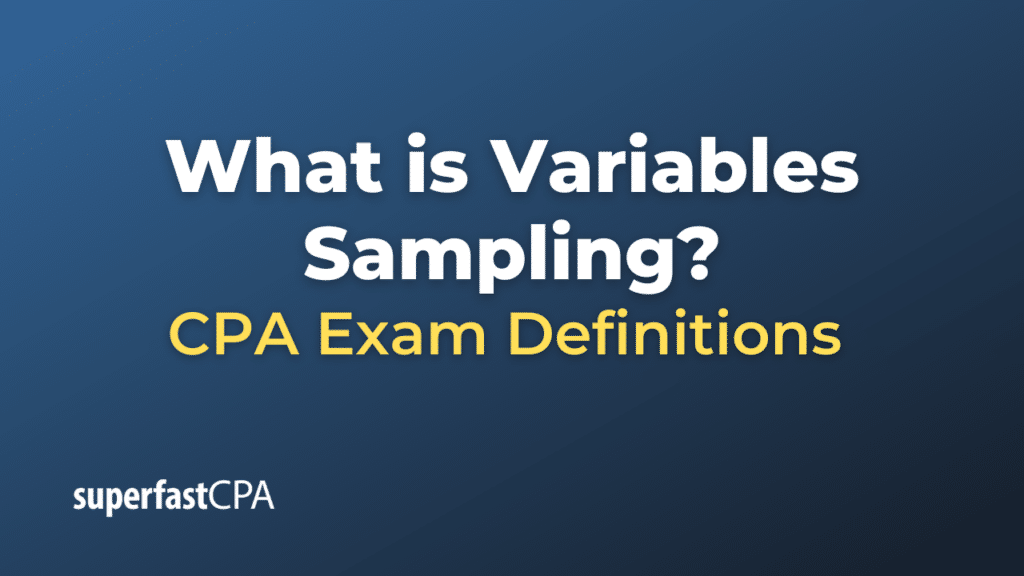Variables Sampling
Variable sampling, also known as variable-rate sampling or continuous sampling, is a statistical method used for auditing or quality control. Unlike attribute sampling, which looks at data in a binary way (e.g., pass/fail, yes/no, defective/non-defective), variable sampling evaluates characteristics that can be measured and quantified on a continuous scale. These characteristics can include weight, length, time, cost, temperature, and so on.
The main objective of variable sampling is often to determine the mean, variance, or other statistical attributes of a population based on a sample. By using variable sampling, auditors or quality control professionals can make inferences about the entire population from which the sample is drawn.
Features:
- Precision: Variable sampling often provides more precise estimates compared to attribute sampling, but it may require a more complex sampling and analysis process.
- Range of Values: It deals with a range of numerical values, allowing for more nuanced analysis.
- Statistical Measures: Mean, standard deviation, and other statistical measures can be estimated.
- Resource Intensive: The data collection and analysis process may require specialized knowledge or equipment to measure the variables under consideration.
Examples in Different Contexts:
- Quality Control in Manufacturing: A factory that produces metal screws may use variable sampling to measure the length and diameter of screws to ensure they meet specified criteria. A random sample of screws might be selected and their dimensions measured precisely.
- Auditing: An auditor may use variable sampling to verify the valuation of accounts receivable in a company’s financial records. Rather than checking each entry, a sample might be taken to estimate the overall valuation accuracy.
- Environmental Monitoring: Variable sampling may be used to measure the level of pollutants in a river at different times and places.
- Healthcare: In a hospital, variable sampling might be used to measure the time it takes to administer treatment from the moment a patient arrives, aiming to improve service delivery and patient care.
Procedures:
- Define the Objective: Clearly state what you intend to find out.
- Select the Sample: Use random sampling or another appropriate method to select a representative sample.
- Collect Data: Measure the variable(s) in the selected sample.
- Analyze Data: Calculate statistical measures like the mean, variance, etc., to make inferences about the population.
- Draw Conclusions: Use the sample statistics to estimate population parameters and assess the quality, make predictions, or take corrective action as needed.
Variable sampling is a versatile and informative method but does require a more detailed level of measurement and often a larger sample size for the same level of confidence and precision compared to attribute sampling.
Example of Variables Sampling
Certainly! Let’s consider a simplified example from a manufacturing context to illustrate how variable sampling might work.
Scenario:
Imagine you work at a factory that produces screws. Each screw needs to be 5 cm long to meet the quality standards. You want to conduct a variable sampling test to ensure that the screws meet the required length criteria.
Step 1: Define the Objective
Your objective is to determine whether the screws being produced are, on average, 5 cm long and to estimate the variability in length.
Step 2: Select the Sample
You decide to randomly select 50 screws from one day’s production. These screws constitute your sample.
Step 3: Collect Data
You measure the length of each of the 50 screws in the sample to the nearest millimeter. Your measurements yield the following lengths in cm (simplified data):
4.9, 5.1, 5.0, 4.8, 5.2, 4.9, 5.1, 5.0, 5.0, 5.1,
4.8, 4.9, 5.2, 4.9, 5.0, 5.1, 4.9, 4.8, 5.0, 5.1,
4.9, 5.0, 5.0, 4.9, 5.1, 5.2, 4.8, 4.8, 5.1, 4.9,
5.0, 5.2, 5.1, 4.9, 4.8, 5.0, 4.9, 5.1, 5.2, 4.8,
5.1, 5.0, 5.0, 4.9, 5.1, 4.8, 4.9, 5.0, 5.1, 5.0Step 4: Analyze Data
- Calculate the Mean: The average length of the screws in your sample. (Sum of all lengths)/50
- Calculate the Standard Deviation: To understand how much individual measurements deviate from the mean.
Suppose, for this data set, you find:
- Mean Length = 5.0 cm
- Standard Deviation = 0.1 cm
Step 5: Draw Conclusions
Your mean length is exactly 5.0 cm, which is in line with the factory standards. The standard deviation of 0.1 cm suggests that almost all screws will fall within 4.9 cm to 5.1 cm, which might be within acceptable quality limits.
You can then decide if the production process is sufficiently under control or if adjustments are needed to decrease the variability (i.e., lower the standard deviation).
This is a simplified example, but it demonstrates the basic steps and considerations involved in a variable sampling process. The variable being sampled here is the length of screws, and we used statistical measures (mean and standard deviation) to make an inference about the entire population of screws produced that day.













